Lexmark CS310N, CS310DN User Manual
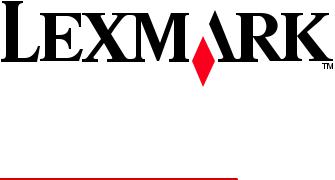
CS310 Series
User's Guide
September 2012 |
www.lexmark.com |
|
|
Machine type(s):
5027
Model(s):
210, 230

Contents |
2 |
Contents |
|
Safety information....................................................................................... |
5 |
Learning about the printer........................................................................... |
7 |
Finding information about the printer...................................................................................................... |
7 |
Selecting a location for the printer............................................................................................................ |
8 |
Printer configurations............................................................................................................................... |
9 |
Using the printer control panel............................................................................................................... |
10 |
Understanding the colors of the indicator and Sleep button lights........................................................ |
11 |
Using the Embedded Web Server........................................................................................................... |
11 |
Additional printer setup............................................................................. |
13 |
Installing internal options........................................................................................................................ |
13 |
Installing hardware options..................................................................................................................... |
17 |
Attaching cables...................................................................................................................................... |
19 |
Setting up the printer software............................................................................................................... |
20 |
Networking.............................................................................................................................................. |
22 |
Verifying printer setup............................................................................................................................ |
27 |
Loading paper and specialty media............................................................ |
29 |
Setting the paper size and type............................................................................................................... |
29 |
Configuring Universal paper settings...................................................................................................... |
29 |
Loading the 250 sheet tray..................................................................................................................... |
29 |
Loading the 650 sheet duo tray.............................................................................................................. |
32 |
Loading the multipurpose feeder............................................................................................................ |
33 |
Loading the manual feeder..................................................................................................................... |
36 |
Linking and unlinking trays...................................................................................................................... |
38 |
Paper and specialty media guide................................................................ |
40 |
Using specialty media.............................................................................................................................. |
40 |
Paper guidelines...................................................................................................................................... |
43 |
Supported paper sizes, types, and weights............................................................................................. |
47 |
Printing...................................................................................................... |
50 |
Printing a document................................................................................................................................ |
50 |
Printing information pages...................................................................................................................... |
52 |

Contents |
3 |
Canceling a print job................................................................................................................................ |
52 |
Understanding the printer menus.............................................................. |
53 |
Menus list................................................................................................................................................ |
53 |
Supplies menu......................................................................................................................................... |
53 |
Paper menu............................................................................................................................................. |
54 |
Reports menu.......................................................................................................................................... |
64 |
Network/Ports menu............................................................................................................................... |
65 |
Security menu......................................................................................................................................... |
72 |
Settings menu.......................................................................................................................................... |
73 |
Saving money and the environment........................................................... |
89 |
Saving paper and toner........................................................................................................................... |
89 |
Saving energy.......................................................................................................................................... |
90 |
Recycling.................................................................................................................................................. |
93 |
Securing the printer................................................................................... |
95 |
Statement of Volatility............................................................................................................................ |
95 |
Erasing volatile memory.......................................................................................................................... |
95 |
Erasing non volatile memory.................................................................................................................. |
95 |
Finding printer security information....................................................................................................... |
96 |
Maintaining the printer.............................................................................. |
97 |
Cleaning the printer parts....................................................................................................................... |
97 |
Checking the status of parts and supplies............................................................................................... |
97 |
Estimated number of remaining pages................................................................................................... |
98 |
Ordering supplies.................................................................................................................................... |
98 |
Storing supplies..................................................................................................................................... |
100 |
Replacing supplies................................................................................................................................. |
100 |
Moving the printer................................................................................................................................ |
121 |
Managing the printer............................................................................... |
122 |
Finding advanced networking and administrator information............................................................. |
122 |
Checking the virtual display................................................................................................................... |
122 |
Viewing reports..................................................................................................................................... |
122 |
Configuring supply notifications from the Embedded Web Server....................................................... |
122 |
Modifying confidential print settings.................................................................................................... |
123 |
Copying printer settings to other printers............................................................................................. |
124 |

Contents |
4 |
Restoring factory default settings......................................................................................................... |
124 |
Clearing jams............................................................................................ |
125 |
Avoiding jams........................................................................................................................................ |
125 |
Understanding jam messages and locations......................................................................................... |
127 |
Jam, manual feeder [251.xx]................................................................................................................. |
128 |
Jam, MP feeder [250.xx]........................................................................................................................ |
128 |
Jam, standard bin [203.xx].................................................................................................................... |
130 |
Jam, front door [20y.xx]........................................................................................................................ |
131 |
Jam, duplex area. Open front door. [23y.xx]......................................................................................... |
132 |
Jam, fuser. Open front door. [202.xx]................................................................................................... |
133 |
Jam, tray [x] [24y.xx]............................................................................................................................. |
134 |
Troubleshooting....................................................................................... |
136 |
Understanding the printer messages.................................................................................................... |
136 |
Solving printer problems....................................................................................................................... |
146 |
Solving print problems.......................................................................................................................... |
152 |
Embedded Web Server does not open................................................................................................. |
178 |
Contacting customer support................................................................................................................ |
179 |
Notices..................................................................................................... |
180 |
Product information.............................................................................................................................. |
180 |
Edition notice........................................................................................................................................ |
180 |
Power consumption.............................................................................................................................. |
184 |
Index........................................................................................................ |
192 |
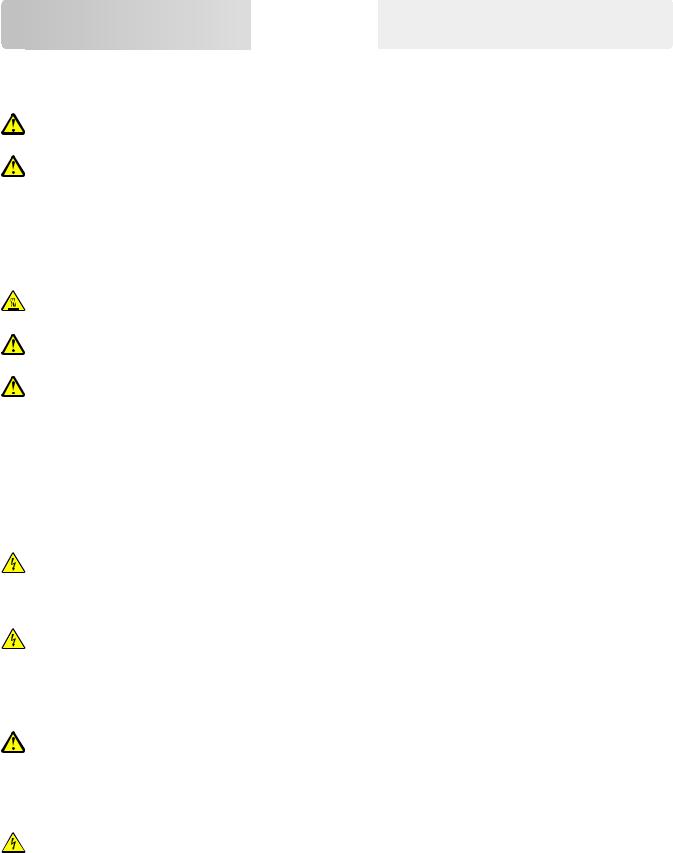
Safety information |
5 |
Safety information





Connect the power cord to a properly grounded electrical outlet that is near the product and easily accessible.
Do not place or use this product near water or wet locations.
CAUTION—POTENTIAL INJURY: This product uses a laser. Use of controls or adjustments or performance of procedures other than those specified herein may result in hazardous radiation exposure.
CAUTION—POTENTIAL INJURY: The lithium battery in this product is not intended to be replaced. There is a danger of explosion if a lithium battery is incorrectly replaced. Do not recharge, disassemble, or incinerate a lithium battery. Discard used lithium batteries according to the manufacturer's instructions and local regulations.
This product uses a printing process that heats the print media, and the heat may cause the media to release emissions. You must understand the section in your operating instructions that discusses the guidelines for selecting print media to avoid the possibility of harmful emissions.
CAUTION—HOT SURFACE: The inside of the printer might be hot. To reduce the risk of injury from a hot component, allow the surface to cool before touching.
CAUTION—POTENTIAL INJURY: The printer weight is greater than 18 kg (40 lb) and requires two or more trained personnel to lift it safely.
CAUTION—POTENTIAL INJURY: Before moving the printer, follow these guidelines to avoid personal injury or printer damage:
•Turn the printer off using the power switch, and then unplug the power cord from the electrical outlet.
•Disconnect all cords and cables from the printer before moving it.
•Lift the printer off the optional tray, and then set it aside instead of trying to lift the tray and printer at the same time.
Note: Use the handholds located on both sides of the printer to lift it.
Use only the power cord provided with this product or the manufacturer's authorized replacement.
CAUTION—SHOCK HAZARD: If you are accessing the controller board or installing optional hardware or memory devices sometime after setting up the printer, then turn the printer off, and unplug the power cord from the electrical outlet before continuing. If you have any other devices attached to the printer, then turn them off as well, and unplug any cables going into the printer.
CAUTION—SHOCK HAZARD: Make sure that all external connections (such as Ethernet and telephone system connections) are properly installed in their marked plug-in ports.
This product is designed, tested, and approved to meet strict global safety standards with the use of specific manufacturer's components. The safety features of some parts may not always be obvious. The manufacturer is not responsible for the use of other replacement parts.
CAUTION—POTENTIAL INJURY: Do not cut, twist, bind, crush, or place heavy objects on the power cord. Do not subject the power cord to abrasion or stress. Do not pinch the power cord between objects such as furniture and walls. If any of these things happen, a risk of fire or electrical shock results. Inspect the power cord regularly for signs of such problems. Remove the power cord from the electrical outlet before inspecting it.
Refer service or repairs, other than those described in the user documentation, to a service representative.
CAUTION—SHOCK HAZARD: To avoid the risk of electrical shock when cleaning the exterior of the printer, unplug the power cord from the electrical outlet and disconnect all cables from the printer before proceeding.

Safety information |
6 |
CAUTION—POTENTIAL INJURY: To reduce the risk of equipment instability, load each tray separately. Keep all other trays closed until needed.
SAVE THESE INSTRUCTIONS.

Learning about the printer |
7 |
Learning about the printer

Finding information about the printer
|
What are you looking for? |
Find it here |
|
|
|
|
|
|
Initial setup instructions: |
Setup documentation—The setup documentation came |
|
|
• |
Connecting the printer |
with the printer and is also available on the Lexmark Web |
|
• Installing the printer software |
site at http://support.lexmark.com. |
|
|
|
||
|
|
|
|
|
Additional setup and instructions for using the printer: |
User's Guide and Quick Reference Guide—The guides are |
|
|
• Selecting and storing paper and specialty media |
available on the Software and Documentation CD. |
|
|
• |
Loading paper |
For updates, visit our Web site at |
|
http://support.lexmark.com. |
||
|
• |
Configuring printer settings |
|
|
|
||
|
• Viewing and printing documents and photos |
|
|
|
• Setting up and using the printer software |
|
|
|
• Configuring the printer on a network |
|
|
|
• Caring for and maintaining the printer |
|
|
|
• Troubleshooting and solving problems |
|
|
|
|
|
|
|
Instructions for: |
Networking Guide—Open the Software and |
|
|
• Connecting the printer to an Ethernet network |
Documentation CD, and then look for Printer and |
|
|
• Troubleshooting printer connection problems |
Software Documentation under the Pubs folder. From |
|
|
the list of publications, click the Networking Guide link. |
||
|
|
|
|
|
|
|
|
|
Help using the printer software |
Windows or Mac Help—Open a printer software program |
|
|
|
|
or application, and then click Help. |
|
|
|
Click ? to view context sensitive information. |
|
|
|
Notes: |
|
|
|
• Help is automatically installed with the printer |
|
|
|
software. |
|
|
|
• The printer software is located in the printer |
|
|
|
program folder or on the desktop, depending on |
|
|
|
your operating system. |
|
|
|
|
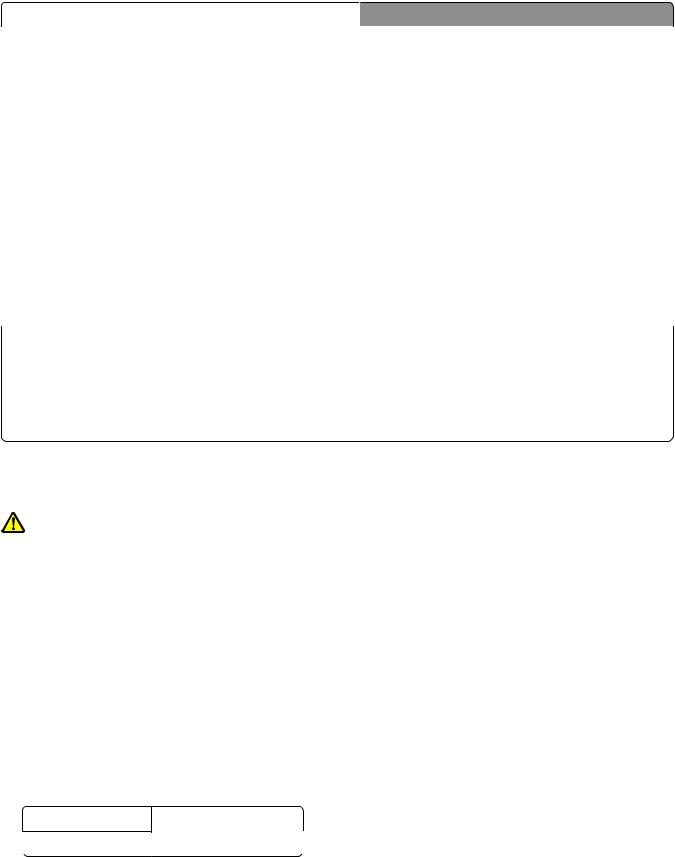
Learning about the printer |
|
8 |
||
|
|
|
|
|
|
What are you looking for? |
Find it here |
||
|
|
|
||
|
The latest supplemental information, updates, and customer |
Lexmark Support Web site— |
||
|
support: |
http://support.lexmark.com |
||
|
• |
Documentation |
Note: Select your country or region, and then select |
|
|
• |
Driver downloads |
your product to view the appropriate support site. |
|
|
• |
Live chat support |
Support telephone numbers and hours of operation for |
|
|
• |
E mail support |
your country or region can be found on the Support Web |
|
|
site or on the printed warranty that came with your |
|||
|
• |
Voice support |
printer. |
|
|
|
|
Record the following information (located on the store |
|
|
|
|
receipt and at the back of the printer), and have it ready |
|
|
|
|
when you contact customer support so that they may |
|
|
|
|
serve you faster: |
|
|
|
|
• |
Machine Type number |
|
|
|
• |
Serial number |
|
|
|
• |
Date purchased |
|
|
|
• |
Store where purchased |
|
|
|
||
|
Warranty information |
Warranty information varies by country or region: |
||
|
|
|
• In the US—See the Statement of Limited Warranty |
|
|
|
|
|
included with this printer, or at |
|
|
|
|
http://support.lexmark.com. |
|
|
|
• In other countries and regions—See the printed |
|
|
|
|
|
warranty that came with your printer. |
|
|
|
|
|
Selecting a location for the printer
CAUTION—POTENTIAL INJURY: The printer weight is greater than 18 kg (40 lb) and requires two or more trained personnel to lift it safely.
When selecting a location for the printer, leave enough room to open trays, covers, and doors. If you plan to install any options, then leave enough room for them also. It is important to:
•Set up the printer near a properly grounded and easily accessible electrical outlet.
•Make sure airflow in the room meets the latest revision of the ASHRAE 62 standard or the CEN Technical Committee 156 standard.
•Provide a flat, sturdy, and stable surface.
•Keep the printer:
–Clean, dry, and free of dust.
–Away from stray staples and paper clips.
–Away from the direct airflow of air conditioners, heaters, or ventilators.
–Free from direct sunlight and humidity extremes.
•Observe the recommended temperatures and avoid fluctuations:
Ambient temperature 15.6 to 32.2°C (60 to 90°F)
 Storage temperature -40 to 43°C (-40 to 110°F)
Storage temperature -40 to 43°C (-40 to 110°F) 
• Allow the following recommended amount of space around the printer for proper ventilation:
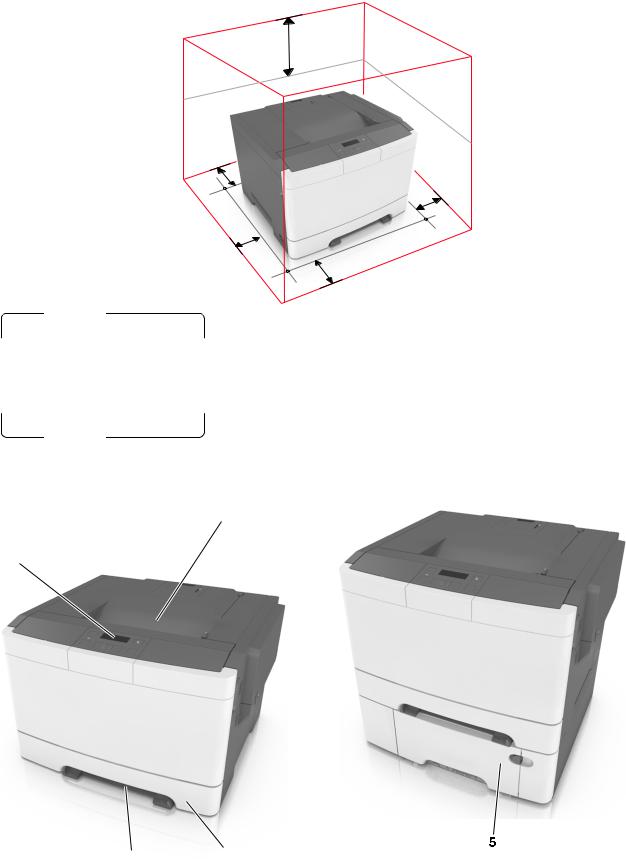
Learning about the printer |
9 |
5
4
1
3
2
1 |
Right side |
152.4 mm (6 in.) |
|
|
|
2 |
Front |
508 mm (20 in.) |
|
|
|
3 |
Left side |
76.2 mm (3 in.) |
|
|
|
4 |
Rear |
101.6 mm (4 in.) |
|
|
|
5 |
Top |
254 mm (10 in.) |
|
|
|
Printer configurations
2
1
4 |
3 |
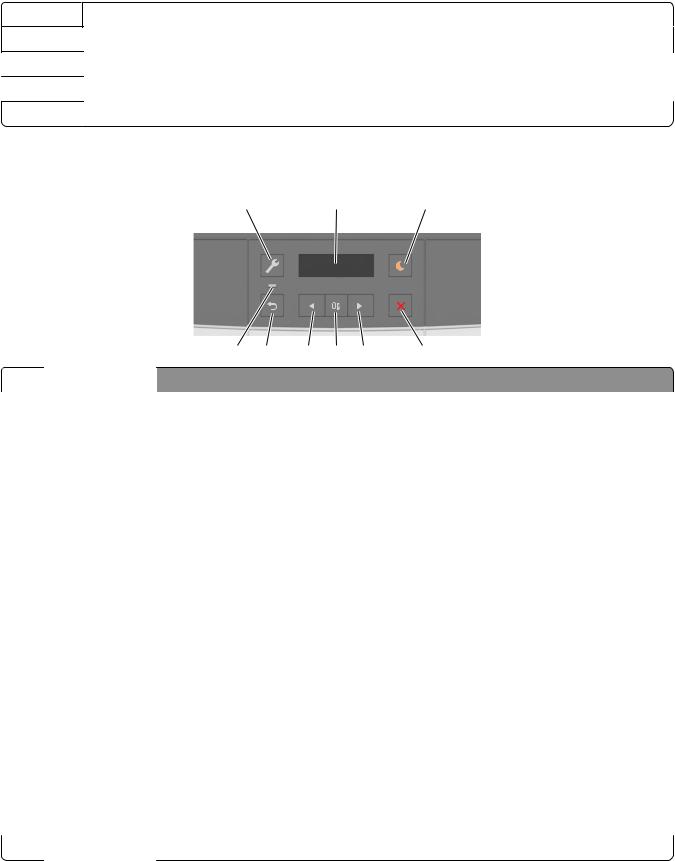
Learning about the printer |
10 |
1 |
Printer control panel |
2Standard bin
3250-sheet tray (Tray 1)
4Manual feeder
5 |
Optional 650-sheet duo tray with integrated multipurpose feeder (Tray 2) |
Using the printer control panel
1 |
2 |
3 |
|
|
|
|
9 |
8 |
7 |
6 |
5 |
4 |
|
|
|
|
|
|
|
|
|
|
|
|
Use the |
To |
|
|
|
|
|
|
|
|
|
|
|
|
|
|
|
|
|
1 |
Menus button |
Open the menus. |
|
|
|
|
|
|
|
|
|
Notes: |
|
|
|
|
|
|
|
|
|
• The menus are available only when the printer is in Ready state. |
||||||
|
|
|
• Pressing the button while in a menu item lets you return to the top level menu screen. |
||||||
|
|
|
|
||||||
|
2 |
Display |
View printing options as well as status and error messages. |
||||||
|
|
|
|
|
|||||
|
3 |
Sleep button |
Enable Sleep mode or Hibernate mode. |
|
|||||
|
|
|
Notes: |
|
|
|
|
|
|
|
|
|
• Pressing any hard button, sending a print job, or performing a power on reset with the |
||||||
|
|
|
|
main power switch wakes the printer from Sleep mode. |
|||||
|
|
|
• Pressing the Sleep button or performing a power on reset with the main power switch |
||||||
|
|
|
|
wakes the printer from Hibernate mode. |
|
||||
|
|
|
|
|
|
|
|
||
|
4 |
Stop button |
Stop printer activity. |
|
|
|
|
||
|
|
|
|
||||||
|
5 |
Right arrow button |
• Scroll through menus or move between screens and menu options. |
||||||
|
|
|
• Increase the numeric value of an option or setting being displayed. |
||||||
|
|
|
|
|
|
|
|
|
|
|
6 |
Select button |
• |
Select menu options. |
|
|
|
|
|
|
|
|
• |
Save settings. |
|
|
|
|
|
|
|
|
|
||||||
|
7 |
Left arrow button |
• Scroll through menus or move between screens and menu options. |
||||||
|
|
|
• Decrease the numeric value of an option or setting being displayed. |
||||||
|
|
|
|
|
|
|
|||
|
8 |
Back button |
Return to the previous screen. |
|
|
|
|||
|
|
|
|
|
|
||||
|
9 |
Indicator light |
Determine the status of the printer. |
|
|
||||
|
|
|
|
|
|
|
|
|
|
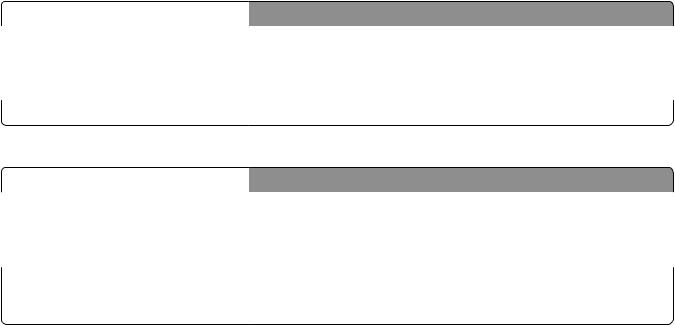
Learning about the printer |
11 |
Understanding the colors of the indicator and Sleep button lights
The colors of the indicator and Sleep button lights on the printer control panel signify a certain printer status or condition.
Indicator light color and its corresponding printer status
|
Indicator light |
Printer status |
|
|
|
|
Off |
The printer is off or in Hibernate mode. |
|
|
|
|
Blinking green |
The printer is warming up, processing data, or printing. |
|
|
|
|
Solid green |
The printer is on, but idle. |
|
|
|
|
Blinking red |
The printer requires user intervention. |
|
|
|
Sleep button light color and its corresponding printer status
|
Sleep button light |
Printer status |
|
|
|
|
Off |
The printer is idle or in Ready state. |
|
|
|
|
Solid amber |
The printer is in Sleep mode. |
|
|
|
|
Blinking amber |
The printer is waking from or entering Hibernate mode. |
|
|
|
|
Blinking amber for 0.1 second, then goes |
The printer is in Hibernate mode. |
|
completely off for 1.9 seconds in pulsing |
|
|
pattern |
|
|
|
|
Using the Embedded Web Server
Note: This feature is available only in network printers or printers connected to print servers.
If the printer is installed on a network, then you can use the Embedded Web Server to do the following:
•View the virtual display of the printer control panel.
•Check the status of the printer supplies.
•Configure supply notifications.
•Configure printer settings.
•Configure network settings.
•View reports.
To access the Embedded Web Server for your printer:
1Obtain the printer IP address:
•From the TCP/IP section in the Network/Ports menu
•By printing a network setup page or menu settings page, and then finding the TCP/IP section
Notes:
–An IP address appears as four sets of numbers separated by periods, such as 123.123.123.123.
–If you are using a proxy server, then temporarily disable it to load the Web page correctly.
Learning about the printer |
12 |
2Open a Web browser, and then type the printer IP address in the address field.
3Press Enter.
The Embedded Web Server page appears.

Additional printer setup |
13 |
Additional printer setup


Installing internal options
CAUTION—SHOCK HAZARD: If you are accessing the controller board or installing optional hardware or memory devices sometime after setting up the printer, then turn the printer off, and unplug the power cord from the electrical outlet before continuing. If you have any other devices attached to the printer, then turn them off as well, and unplug any cables going into the printer.
You can customize your printer connectivity and memory capacity by adding optional cards.
Available internal option
Memory card
DDR3 DIMM
Installing a memory card
CAUTION—SHOCK HAZARD: If you are accessing the controller board or installing optional hardware or memory devices sometime after setting up the printer, then turn the printer off, and unplug the power cord from the electrical outlet before continuing. If you have any other devices attached to the printer, then turn them off as well, and unplug any cables going into the printer.
Warning—Potential Damage: Controller board electronic components are easily damaged by static electricity. Touch something metal on the printer before touching any controller board electronic components or connectors.
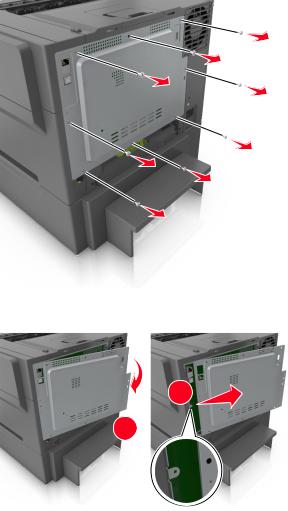
Additional printer setup |
14 |
An optional memory card can be purchased separately and attached to the controller board.
1Access the controller board at the back of the printer.
Note: This task requires a flathead screwdriver.
2Turn the screws counterclockwise to remove them.
3 Slightly open the controller board access cover, and then shift to the right to remove it.
2
1
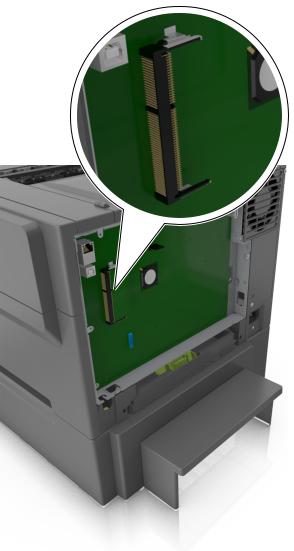
Additional printer setup |
15 |
4 Locate the memory card connector on the controller board.
Warning—Potential Damage: Controller board electronic components are easily damaged by static electricity. Touch something metal on the printer before touching any controller board electronic components or connectors.
5 Unpack the memory card.
Warning—Potential Damage: Do not touch the connection points along the edge of the card. Doing so may damage the memory card.
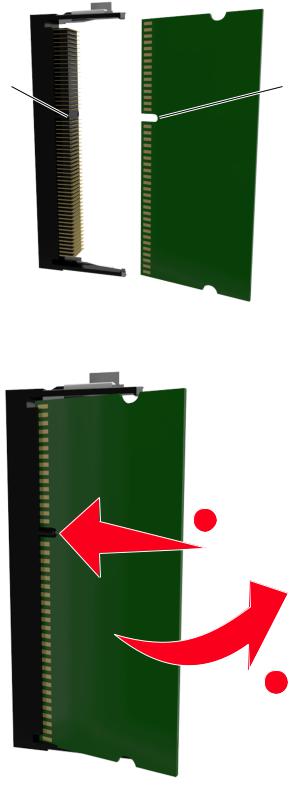
Additional printer setup |
16 |
6 Align the notch (1) on the memory card with the ridge (2) on the connector.
2 |
1 |
7Push the memory card straight into the connector, and then push it into the controller board wall until it clicks into place.
1
2
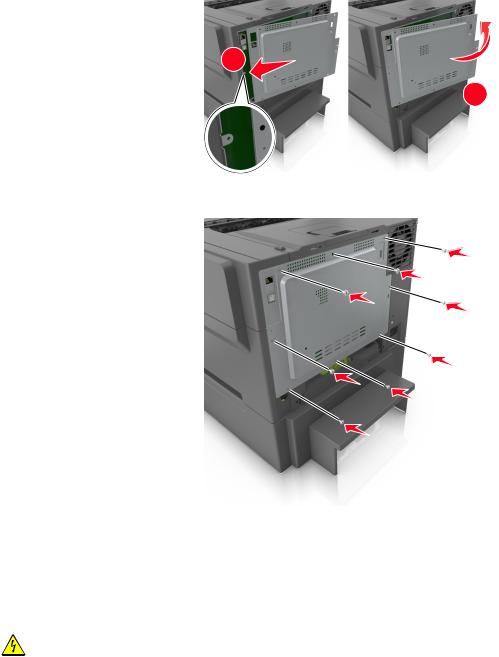
Additional printer setup |
17 |
8 Reattach the cover.
1
2
9 Turn the screws clockwise to lock the cover.
Installing hardware options
Order of installation
CAUTION—SHOCK HAZARD: If you are accessing the controller board or installing optional hardware or memory devices sometime after setting up the printer, then turn the printer off, and unplug the power cord from the electrical outlet before continuing. If you have any other devices attached to the printer, then turn them off as well, and unplug any cables going into the printer.
Install the printer and any optional tray in the following order:
•Optional 650-sheet duo tray with integrated multipurpose feeder
•Printer
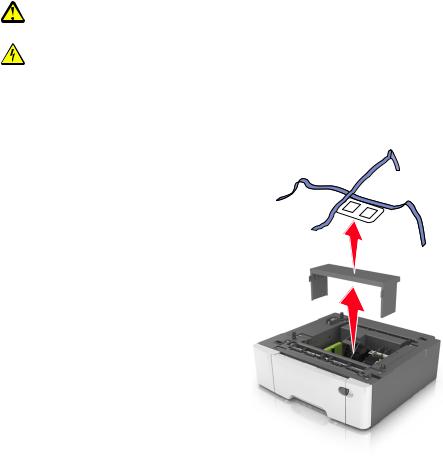
Additional printer setup |
18 |
Installing a 650 sheet duo tray
The printer supports an optional 650 sheet duo tray (Tray 2) with an integrated multipurpose feeder.
CAUTION—POTENTIAL INJURY: The printer weight is greater than 18 kg (40 lb) and requires two or more trained personnel to lift it safely.
CAUTION—SHOCK HAZARD: If you are accessing the controller board or installing optional hardware or memory devices sometime after setting up the printer, then turn the printer off, and unplug the power cord from the electrical outlet before continuing. If you have any other devices attached to the printer, then turn them off as well, and unplug any cables going into the printer.
1 Unpack the optional 650 sheet duo tray, and then remove all packing material and the dust cover.
2 Place the tray in the location chosen for the printer.

Additional printer setup |
19 |
3 Align the printer with the 650 sheet duo tray, and then lower the printer into place.
4 Install the dust cover.
Note: When the printer software and any options are installed, it may be necessary to manually add the options in the printer driver to make them available for print jobs. For more information, see “Updating available options in the printer driver” on page 21.
Attaching cables
Connect the printer to the computer using a USB cable or to the network using an Ethernet cable.
Make sure to match the following:
•The USB symbol on the cable with the USB symbol on the printer
•The appropriate Ethernet cable to the Ethernet port
Warning—Potential Damage: Do not touch the USB cable, any wireless network adapter, or the printer in the area shown while actively printing. A loss of data or a malfunction can occur.
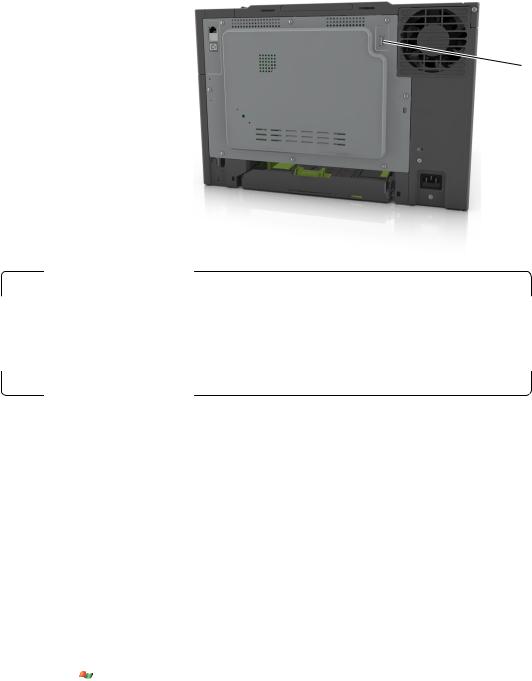
Additional printer setup |
20 |
2
1
3
 4
4
|
|
Use the |
To |
|
|
|
|
|
1 |
USB printer port |
Connect the printer to a computer. |
|
|
|
|
|
2 |
Ethernet port |
Connect the printer to a network. |
|
|
|
|
|
3 |
USB port |
Attach an optional wireless network adapter. |
|
|
|
|
|
4 |
Printer power cord socket |
Connect the printer to a properly grounded electrical outlet. |
|
|
|
|
Setting up the printer software
Installing the printer software
Note: If you installed the printer software on the computer before but need to reinstall the software, then uninstall the current software first.
For Windows users
1Close all open software programs.
2Insert the Software and Documentation CD.
If the installation dialog does not appear after a minute, then launch the CD manually:
aClick  , or click Start and then click Run.
, or click Start and then click Run.
bIn the Start Search or Run dialog, type D:\setup.exe, where D is the letter of your CD or DVD drive.
cPress Enter, or click OK.
3 Click Install, and then follow the instructions on the computer screen.
For Macintosh users
1Close all open applications.
2Insert the Software and Documentation CD.
If the installation dialog does not appear after a minute, then click the CD icon on the desktop.

Additional printer setup |
21 |
3 Double-click the software installer package, and then follow the instructions on the computer screen.
Note: To take advantage of the full features of your printer, select the custom install option, and then select all packages listed.
Using the Internet
1Go to the Lexmark Web site at http://support.lexmark.com.
2Navigate to:
SUPPORT & DOWNLOADS > select your printer > select your operating system
3Download the printer driver, and then install the printer software.
Updating available options in the printer driver
When the printer software and any hardware options are installed, you may need to manually add the options in the printer driver to make them available for print jobs.
For Windows users
1 Open the printers folder.
aClick  , or click Start and then click Run.
, or click Start and then click Run.
bIn the Start Search or Run dialog, type control printers.
cPress Enter, or click OK.
2Select the printer.
3Right click the printer, and then select Properties.
4Click the Configuration tab.
5Do either of the following:
•Click Update Now Ask Printer.
•Under Configuration Options, manually add any installed hardware options.
6Click Apply.
For Macintosh users
1From the Apple menu, navigate to either of the following:
•System Preferences > Print & Scan > select your printer > Options & Supplies > Driver
•System Preferences > Print & Fax > select your printer > Options & Supplies > Driver
2Add any installed hardware options, and then click OK.

Additional printer setup |
22 |
Networking
Notes:
•Purchase a MarkNetTM N8352 wireless network adapter first before setting up the printer on a wireless network. For information on installing the wireless network adapter, see the instruction sheet that came with the adapter.
•A Service Set Identifier (SSID) is a name assigned to a wireless network. Wired Equivalent Privacy (WEP), Wi-Fi Protected Access (WPA), WPA2, and 802.1X - RADIUS are types of security used on a network.
Preparing to set up the printer on an Ethernet network
To configure your printer to connect to an Ethernet network, organize the following information before you begin:
Note: If your network automatically assigns IP addresses to computers and printers, continue on to installing the printer.
•A valid, unique IP address for the printer to use on the network
•The network gateway
•The network mask
•A nickname for the printer (optional)
Note: A printer nickname can make it easier for you to identify your printer on the network. You can choose to use the default printer nickname, or assign a name that is easier for you to remember.
You will need an Ethernet cable to connect the printer to the network and an available port where the printer can physically connect to the network. Use a new network cable when possible to avoid potential problems caused by a damaged cable.
Installing the printer on an Ethernet network
For Windows users
1Insert the Software and Documentation CD.
If the installation dialog does not appear after a minute, then launch the CD manually:
aClick  , or click Start and then click Run.
, or click Start and then click Run.
bIn the Start Search or Run dialog, type D:\setup.exe, where D is the letter of the CD or DVD drive.
cPress Enter, or click OK.
2Click Install, and then follow the instructions on the computer screen.
3Select Ethernet connection, and then click Continue.
4Attach the Ethernet cable when instructed to do so.
5Select the printer from the list, and then click Continue.
Note: If the configured printer does not appear in the list, then click Modify Search.
6 Follow the instructions on the computer screen.
Additional printer setup |
23 |
For Macintosh users
1Allow the network DHCP server to assign an IP address to the printer.
2Obtain the printer IP address either:
•From the printer control panel
•From the TCP/IP section in the Network/Ports menu
•By printing a network setup page or menu settings page, and then finding the TCP/IP section
Note: You will need the IP address if you are configuring access for computers on a different subnet than the printer.
3 Install the printer driver on the computer.
aInsert the Software and Documentation CD, and then double click the installer package for the printer.
bFollow the instructions on the computer screen.
cSelect a destination, and then click Continue.
dFrom the Easy Install screen, click Install.
eType the user password, and then click OK.
All the necessary applications are installed on the computer.
f Click Close when installation is complete.
4 Add the printer.
• For IP printing:
aFrom the Apple menu, navigate to either of the following:
–System Preferences > Print & Scan
–System Preferences > Print & Fax
bClick +.
cClick the IP tab.
dType the printer IP address in the address field, and then click Add.
•For AppleTalk printing:
Notes:
–Make sure AppleTalk is activated on your printer.
–This feature is supported only in Mac OS X version 10.5.
aFrom the Apple menu, navigate to:
System Preferences > Print & Fax
bClick +, and then navigate to: AppleTalk > select your printer > Add
Preparing to set up the printer on a wireless network
Notes:
•Make sure your wireless network adapter is installed in your printer and working properly.
•Make sure your access point (wireless router) is turned on and is working properly.
Additional printer setup |
24 |
Make sure you have the following information before setting up the printer on a wireless network:
•SSID—The SSID is also referred to as the network name.
•Wireless Mode (or Network Mode)—The mode is either infrastructure or ad hoc.
•Channel (for ad hoc networks)—The channel defaults to automatic for infrastructure networks.
Some ad hoc networks will also require the automatic setting. Check with your system support person if you are not sure which channel to select.
•Security Method—There are three basic options for Security Method:
–WEP key
If your network uses more than one WEP key, then enter up to four in the provided spaces. Select the key currently in use on the network by selecting the default WEP transmit key.
or
–WPA or WPA2 preshared key or passphrase
WPA includes encryption as an additional layer of security. The choices are AES or TKIP. Encryption must be set for the same type on the router and on the printer, or the printer will not be able to communicate on the network.
–802.1X–RADIUS
If you are installing the printer on an 802.1X network, then you may need the following:
•Authentication type
•Inner authentication type
•802.1X user name and password
•Certificates
–No security
If your wireless network does not use any type of security, then you will not have any security information.
Note: Using an unsecured wireless network is not recommended.
Notes:
–If you do not know the SSID of the network that your computer is connected to, then launch the wireless utility of the computer network adapter, and then look for the network name. If you cannot find the SSID or the security information for your network, then see the documentation that came with the access point, or contact your system support person.
–To find the WPA/WPA2 preshared key/passphrase for the wireless network, see the documentation that came with the access point, see the Web page associated with the access point, or consult your system support person.
Connecting the printer to a wireless network using Wi Fi Protected Setup
Before connecting the printer to a wireless network, make sure that:
•The access point (wireless router) is Wi Fi Protected Setup (WPS) certified or WPS compatible. For more information, see the documentation that came with your access point.
•A wireless network adapter installed in your printer is attached and working properly. For more information, see the instruction sheet that came with the wireless network adapter.
Additional printer setup |
25 |
Using the Push Button Configuration method
1From the printer control panel, navigate to:
 > Network/Ports >
> Network/Ports >  > Network [x] >
> Network [x] >  > Network [x] Setup >
> Network [x] Setup >  > Wireless >
> Wireless >  > Wi Fi Protected Setup >
> Wi Fi Protected Setup >  > Start Push Button Method >
> Start Push Button Method > 
2Follow the instructions on the printer display.
Using the Personal Identification Number (PIN) method
1From the printer control panel, navigate to:
 > Network/Ports >
> Network/Ports >  > Network [x] >
> Network [x] >  > Network [x] Setup >
> Network [x] Setup >  > Wireless >
> Wireless >  > Wi Fi Protected Setup >
> Wi Fi Protected Setup >  > Start PIN Method >
> Start PIN Method > 
2Copy the eight digit WPS PIN.
3Open a Web browser, and then type the IP address of your access point in the address field.
Notes:
•The IP address appears as four sets of numbers separated by periods, such as 123.123.123.123.
•If you are using a proxy server, then temporarily disable it to load the Web page correctly.
4Access the WPS settings. For more information, see the documentation that came with your access point.
5Enter the eight digit PIN, and then save the setting.
Connecting the printer to a wireless network using the printer software
Using the Wireless Setup Utility (Windows only)
The Wireless Setup Utility lets you:
•Configure the printer to join an existing wireless network.
•Add a printer to an existing ad hoc network.
•Change the wireless settings after installation.
•Install the printer on additional network computers.
Installing the Wireless Setup Utility
1Go to the Lexmark Web site at http://support.lexmark.com.
2Download the latest Wireless Setup Utility.
3Double click the downloaded software installer package.
4Follow the instructions on the computer screen.
Launching the Wireless Setup Utility
Notes:
• Make sure the printer is turned on.

Additional printer setup |
26 |
• Make sure a wireless network adapter installed in your printer is attached and working properly.
1Click  or Start.
or Start.
2Click All Programs or Programs, and then select the printer program folder from the list.
3Select your printer, and then navigate to:
Printer Home > Settings > Wireless Setup Utility
4Follow the instructions on the computer screen.
Using the Wireless Setup Assistant (Macintosh only)
The Wireless Setup Assistant lets you:
•Configure the printer to join an existing wireless network.
•Add a printer to an existing ad hoc network.
•Change the wireless settings after installation.
•Install the printer on additional network computers.
Installing the Wireless Setup Assistant
1Go to the Lexmark Web site at http://support.lexmark.com.
2Download the latest Wireless Setup Assistant application.
3Double click the downloaded software installer package.
4Follow the instructions on the computer screen.
Launching the Wireless Setup Assistant
Notes:
•Make sure the printer is turned on.
•Make sure a wireless network adapter installed in your printer is attached and working properly.
1From the Finder, navigate to:
Applications > select your printer folder
2Double click Wireless Setup Assistant, and then follow the instructions on the computer screen.
Note: If you encounter problems while running the application, then click ? .
Connecting the printer to a wireless network using the Embedded Web Server
Before you begin, make sure that:
•Your printer is connected temporarily to an Ethernet network.
•A wireless network adapter is installed in your printer and working properly. For more information, see the instruction sheet that came with your wireless network adapter.
1 Open a Web browser, and then type the printer IP address in the address field.
Additional printer setup |
27 |
Notes:
•View the printer IP address in the TCP/IP section in the Network/Ports menu. The IP address appears as four sets of numbers separated by periods, such as 123.123.123.123.
•If you are using a proxy server, then temporarily disable it to load the Web page correctly.
2Click Settings > Network/Ports > Wireless.
3Modify the settings to match the settings of your access point (wireless router).
Note: Make sure to enter the correct SSID.
4Click Submit.
5Turn off the printer, and then disconnect the Ethernet cable. Then wait for at least five seconds, and then turn the printer back on.
6To verify if your printer is connected to the network, print a network setup page. Then in the Network Card [x] section, see if the status is “Connected”.
For more information, see the “Verifying printer setup” section of the User’s Guide.
Verifying printer setup
When all hardware and software options are installed and the printer is turned on, verify that the printer is set up correctly by printing the following:
•Menu settings page—Use this page to verify that all printer options are installed correctly. A list of installed options appears toward the bottom of the page. If an option you installed is not listed, then it is not installed correctly. Remove the option, and then install it again.
•Network setup page—If your printer is connected to a network or connected to a print server, print a network setup page to verify the network connection. This page also provides important information that aids network printing configuration.
Printing a menu settings page
Print a menu settings page to review the current menu settings and to verify if the printer options are installed correctly.
Note: If you have not changed any menu settings, then the menu settings page lists all the factory default settings. When you select and save other settings from the menus, they replace the factory default settings as user default settings. A user default setting remains in effect until you access the menu again, choose another value, and save it.
From the printer control panel, navigate to:
 > Reports >
> Reports >  > Menu Settings Page >
> Menu Settings Page > 
Additional printer setup |
28 |
Printing a network setup page
If the printer is connected to a network, then print a network setup page to verify the network connection. This page also provides important information that aids network printing configuration.
1From the printer control panel, navigate to:
 > Reports >
> Reports >  > Network Setup Page >
> Network Setup Page > 
Note: If an optional print server is installed, then Print Network [x] Setup Page appears.
2Check the first section of the network setup page and confirm that the status is Connected.
If the status is Not Connected, then the LAN drop may not be active, or the network cable may be malfunctioning. Consult your system support person for a solution, and then print another network setup page.

Loading paper and specialty media |
29 |
Loading paper
paper and specialty media
and specialty media
The selection and handling of paper and specialty media can affect how reliably documents print. For more information, see “Avoiding jams” on page 125 and “Storing paper” on page 46.
Setting the paper size and type
1From the printer control panel, navigate to:
 > Paper Menu >
> Paper Menu >  > Paper Size/Type >
> Paper Size/Type > 
2 Press the arrow buttons until Tray [x] Size or Tray [x] Type appears, and then press  .
.
3 Select a setting, and then press  .
.
Configuring Universal paper settings
The Universal paper size is a user defined setting that lets you print on paper sizes that are not preset in the printer menus.
Notes:
•The smallest supported Universal size is 76 x 127 mm (3 x 5 inches) and is loaded only in the multipurpose feeder and manual feeder.
•The largest supported Universal size is 215.9 x 359.9 mm (8.5 x 14.17 inches) and is loaded only in the multipurpose feeder and manual feeder.
1From the printer control panel, navigate to:  > Paper Menu >
> Paper Menu >  > Universal Setup
> Universal Setup
2Press the arrow buttons until Units of Measure, Portrait Height, or Portrait Width appears, and then press  .
.
3Select a setting, and then press  .
.
Loading the 250 sheet tray
The printer has one standard 250 sheet tray (Tray 1) with an integrated manual feeder. The 250 sheet tray and the optional 650 sheet duo tray with an integrated multipurpose feeder support the same paper sizes and types and are loaded in the same way.
1 Pull out the tray completely.
Note: Do not remove trays while a job is printing or while Busy appears on the display. Doing so may cause a jam.
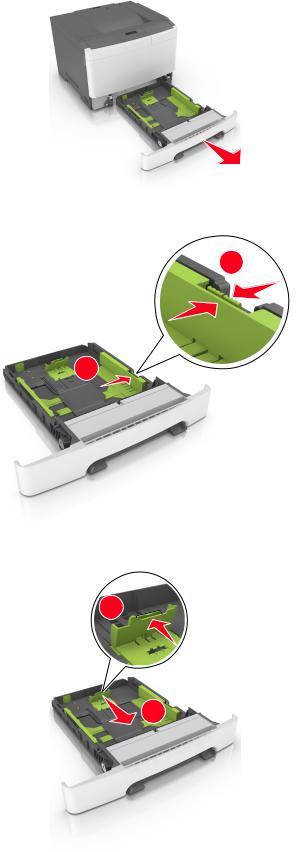
Loading paper and specialty media |
30 |
2 Squeeze, and then slide the width guide tab to the correct position for the paper you are loading.
1
2
3 Squeeze, and then slide the length guide tab to the correct position for the paper you are loading.
1 
2
